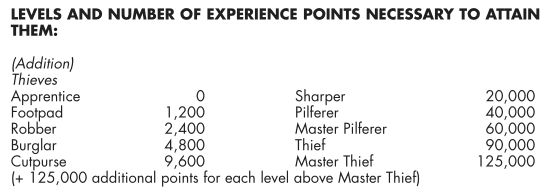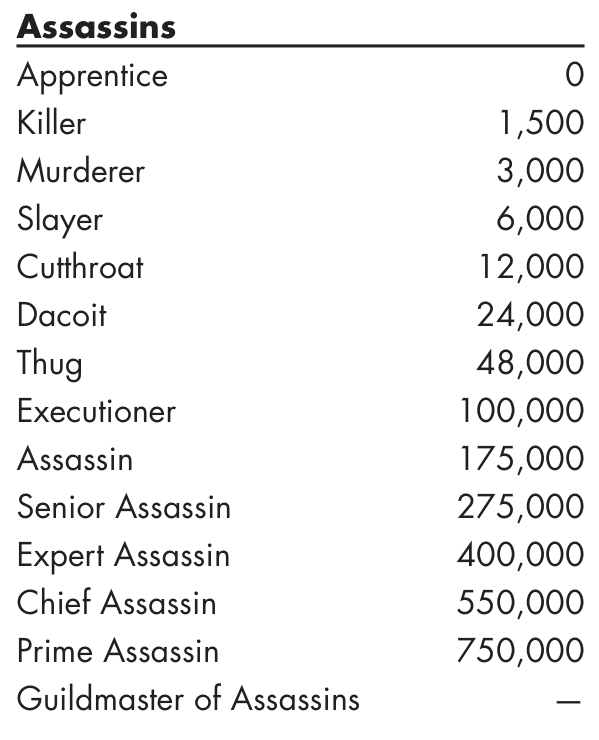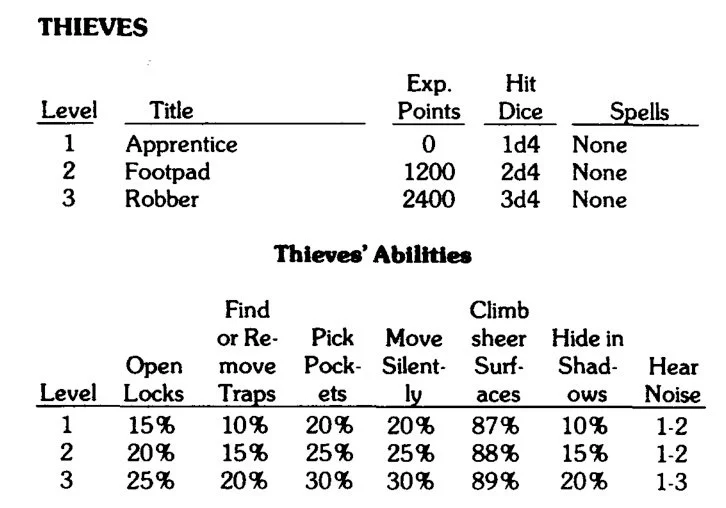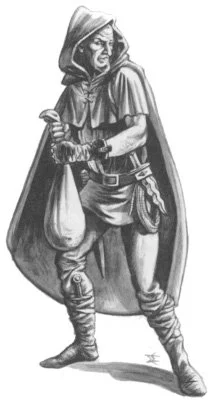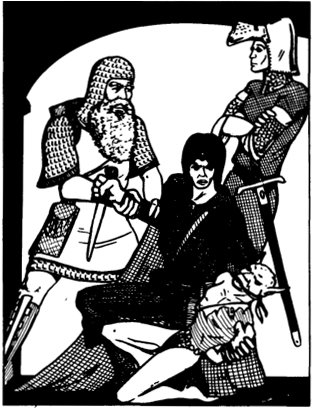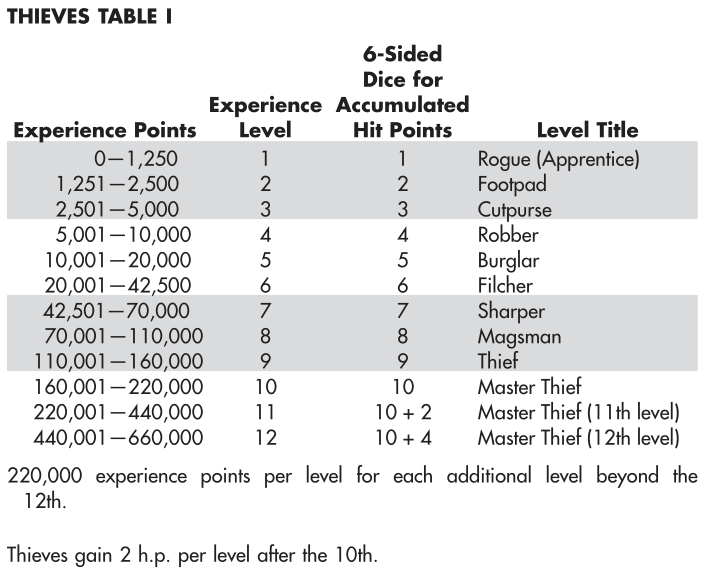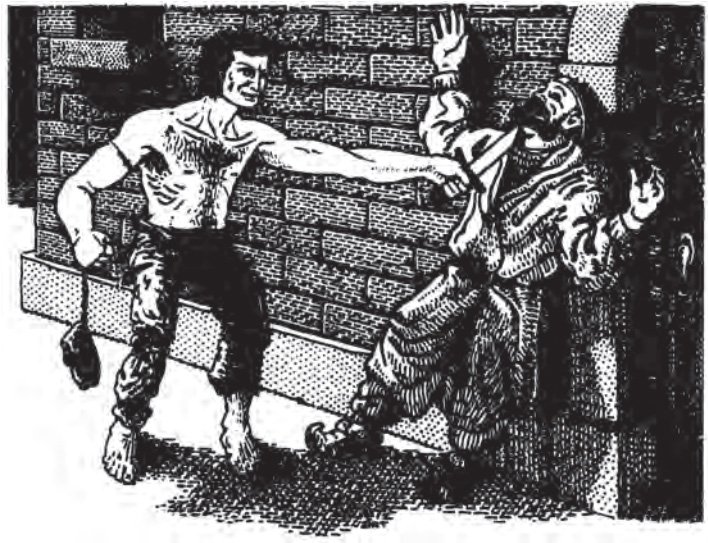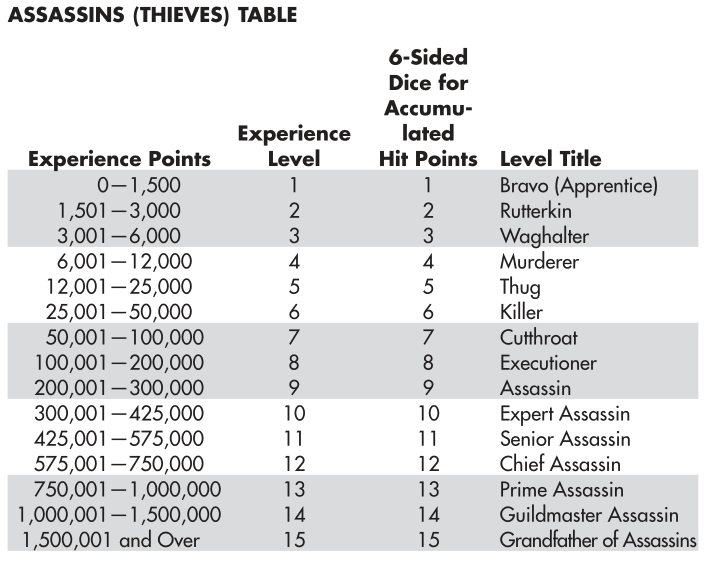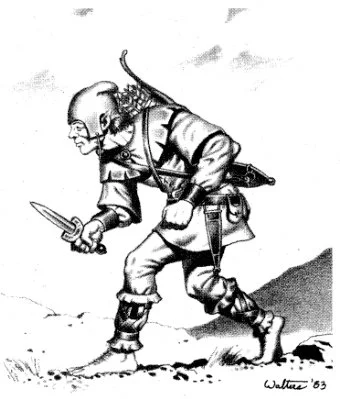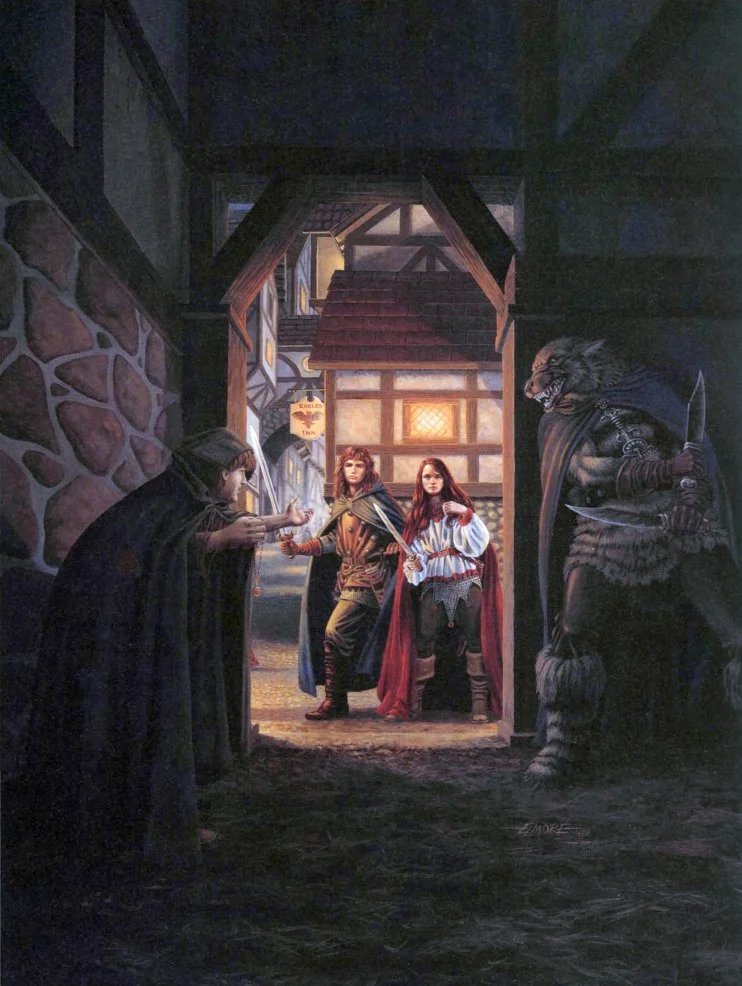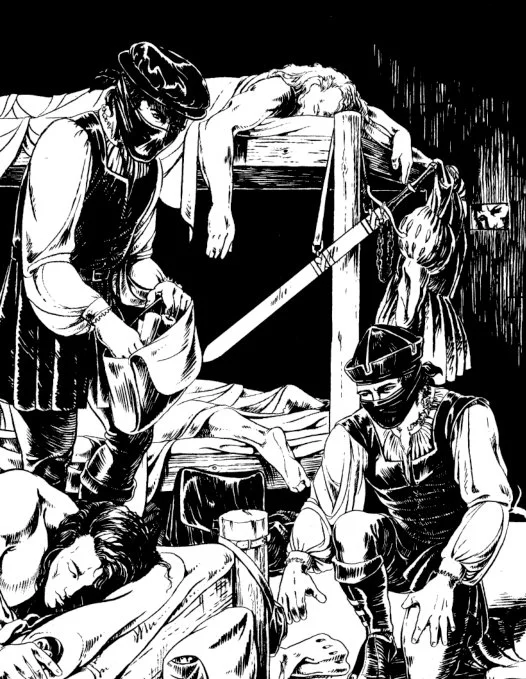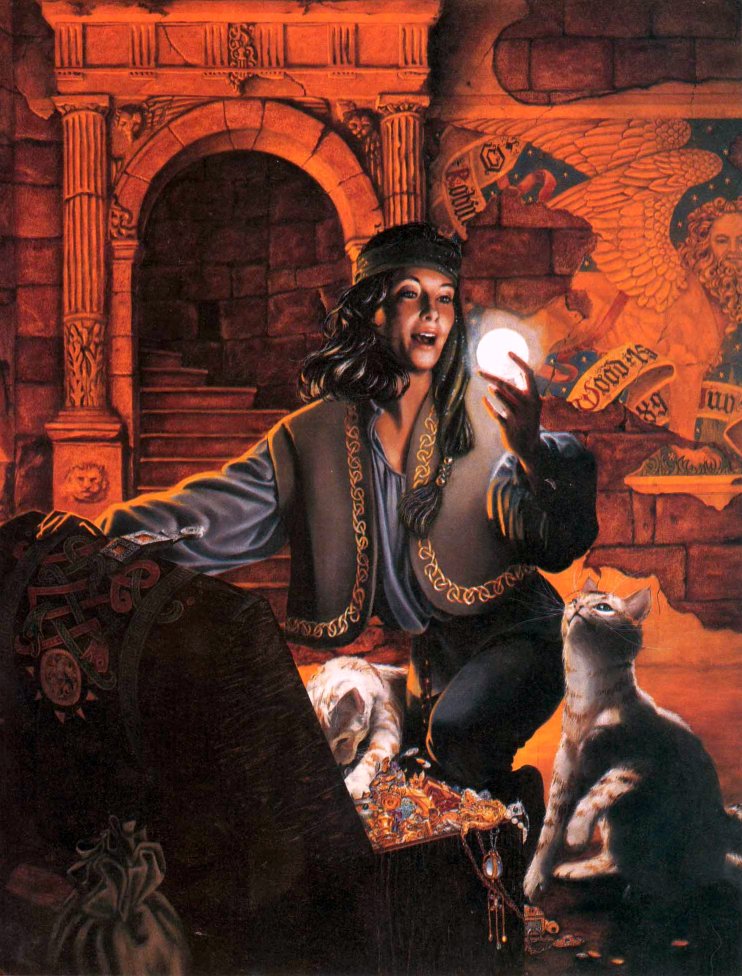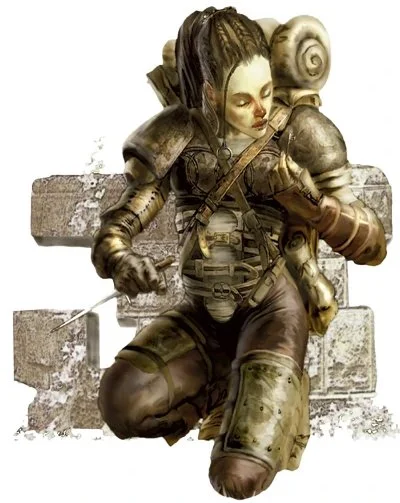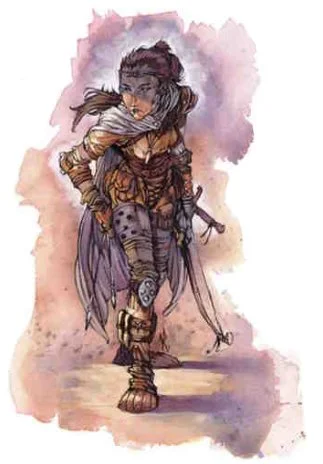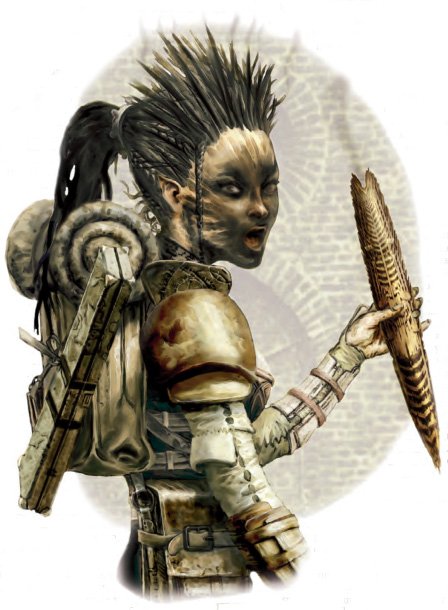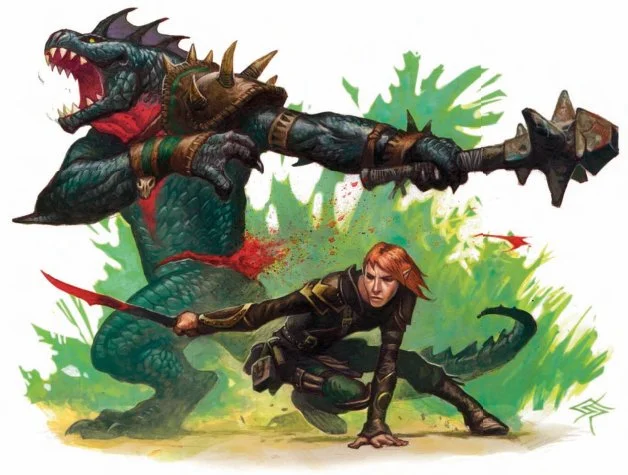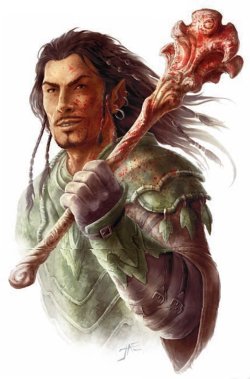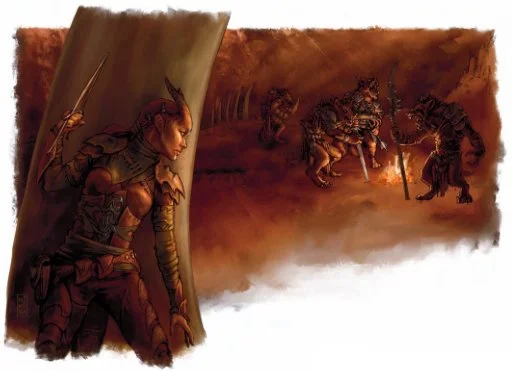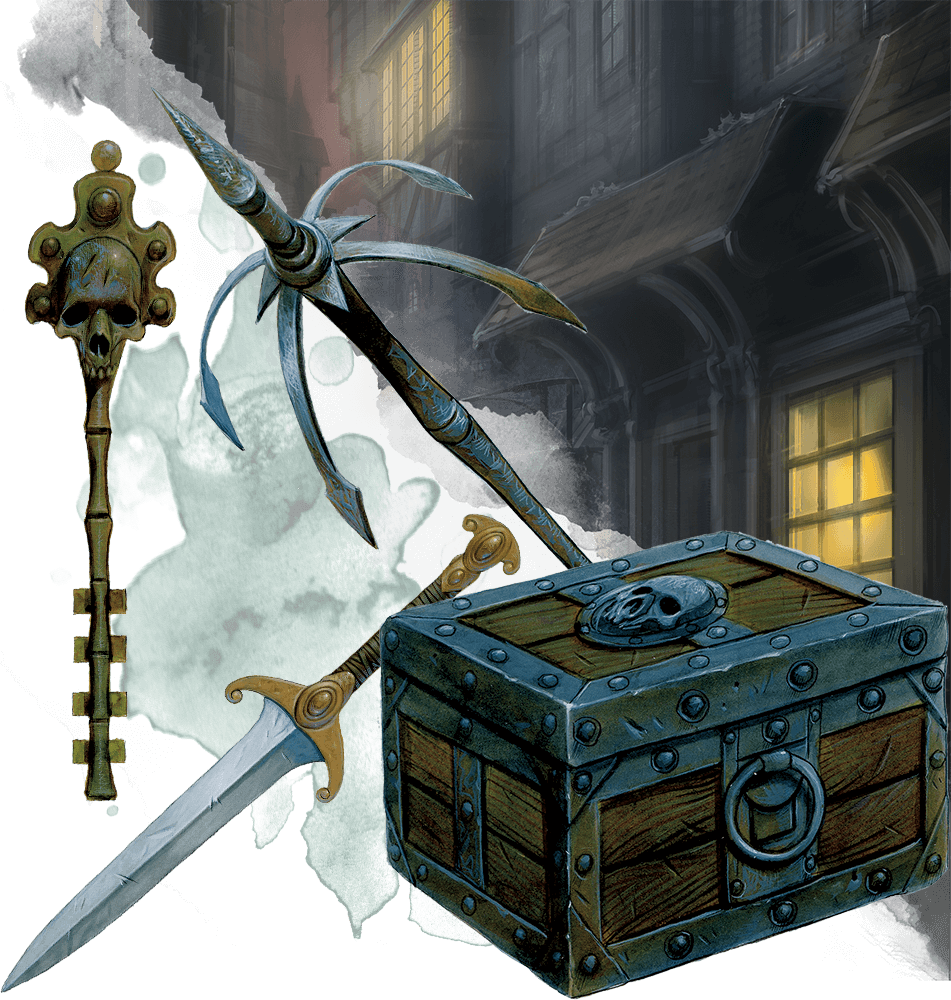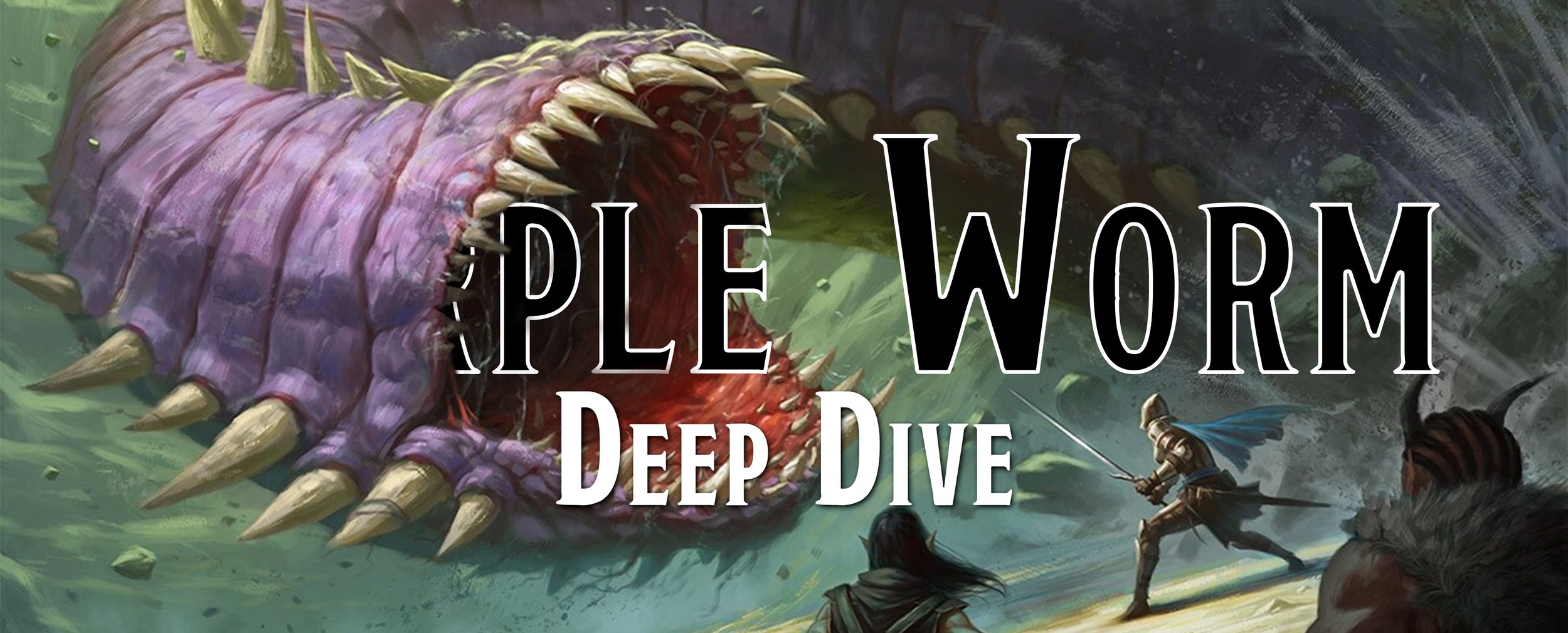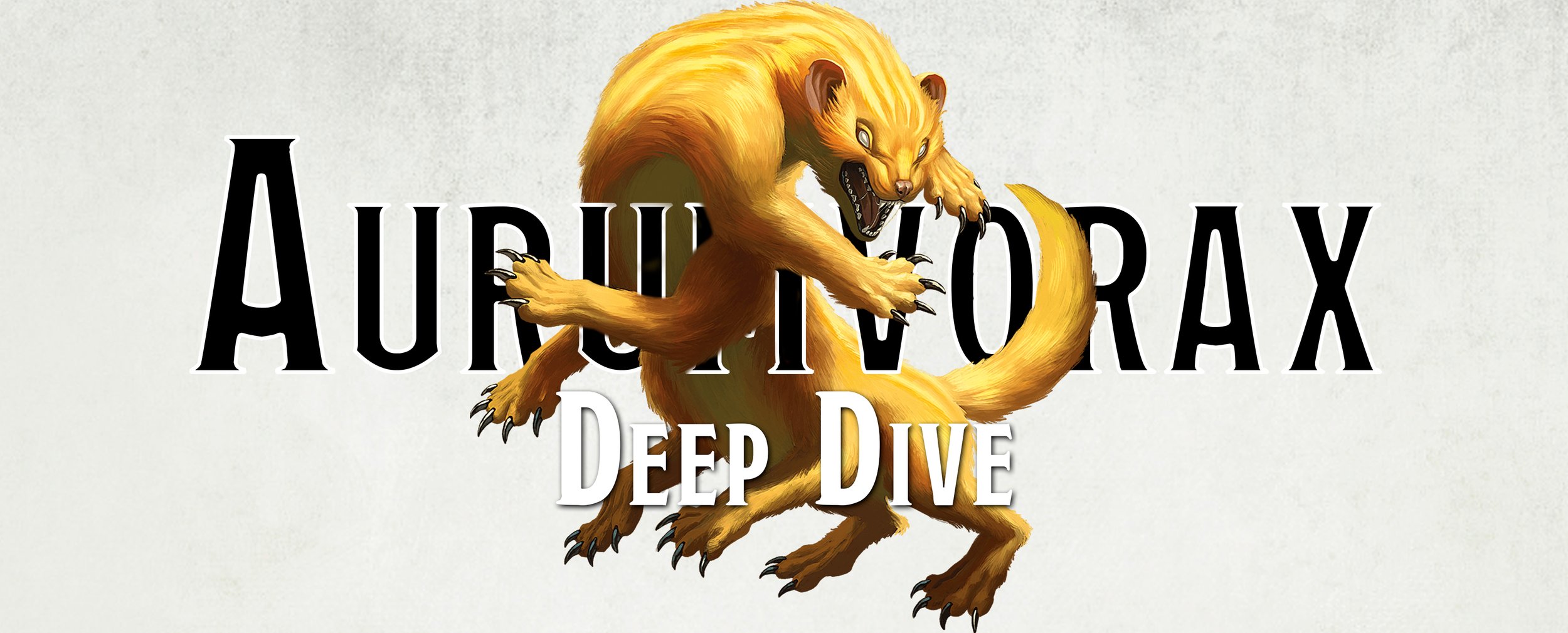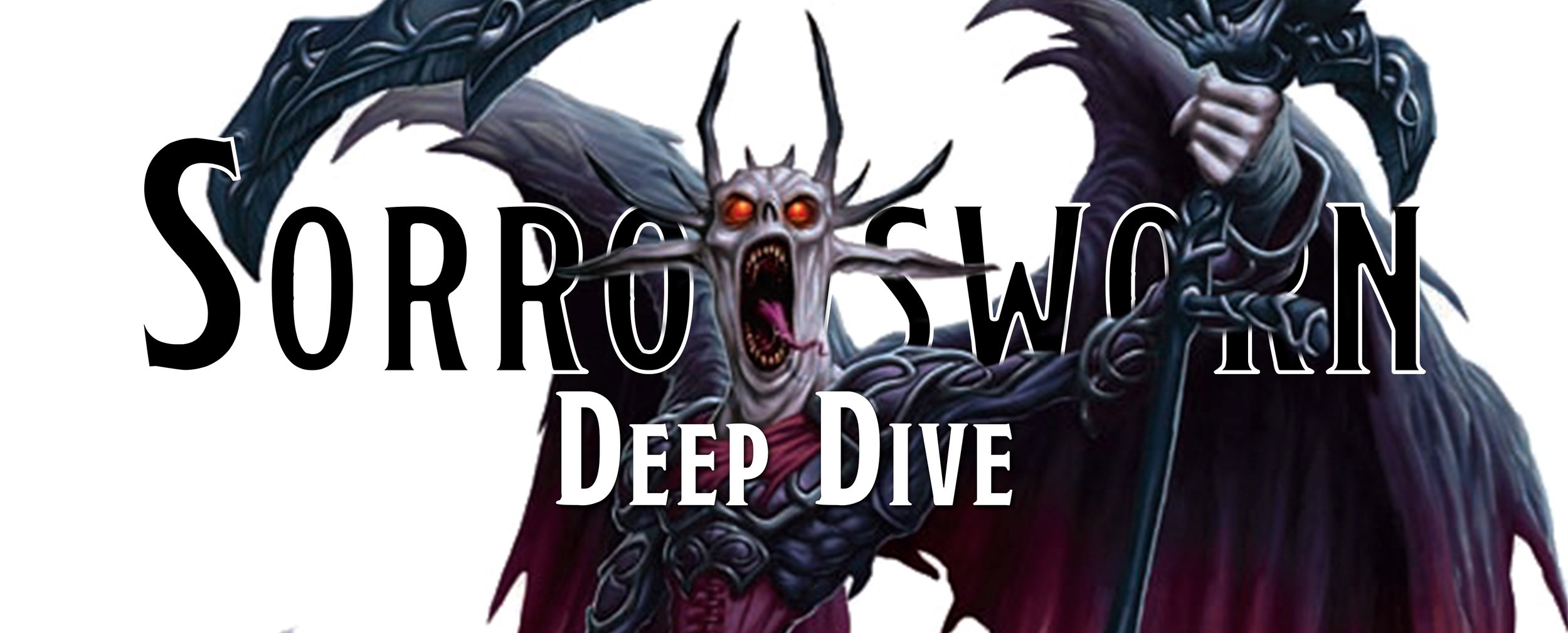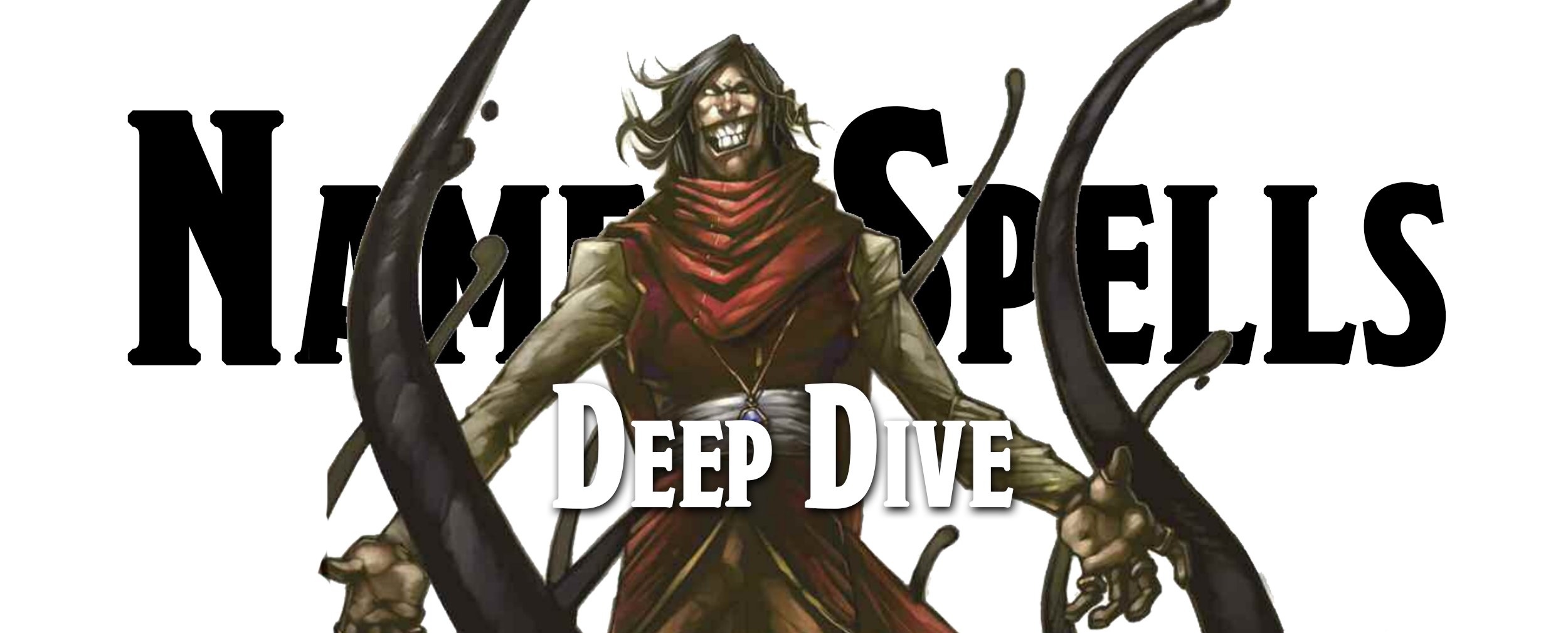Deep Dive - Rogue Class
We return to looking at the history of a class, and this time it is the deadly and dangerous Rogue! Err… is it the Thief? Or the Assassin? Along with changes in the name, there were changes in the class’ abilities, but they are always highly skilled individuals capable of bringing down enemies who don’t even know they are there. Earlier editions had the Rogue as a potential trouble maker within the party dynamics. Nowadays, the only person, we hope, that the Rogue is backstabbing is the bad guy you’re fighting. Let’s explore this class’ very beginnings and see how the Thief, we mean Rogue, has been shaped through the editions.
OD&D - Rogue
Key Features
• Hit Points: d4
• Primary Attribute: Dexterity
• Striking silently from behind provides additional damage
• Has more skills than any other class
Greyhawk, 1975 TSR Inc.
Found in the supplement Greyhawk (1975), the Thief is introduced as a wholly new class, unlike the druid which is a subclass of the cleric. This is the same supplement that introduces paladins, probably as a lawful balance to the chaotic and neutral Thief. That's right, you can't be a lawful Thief, only one focused on chaos or neutrality. Speaking of chaos, if your character is chaotic, it means that the player should also be taking chaotic actions - an example given in the book is that "a chaotic player is usually more prone to stab even his lawless buddy in the back for some desired gain." But the supplement does say that chaos is chaotic, and so you won't always stab your buddy in the back as sometimes you might help them... and then stab them in the back. It's nice to see the game teaching players it's ok to be a pain at the table so long as you shout "It's what my character would do!"
If you were hoping for a table full of chaos, the supplement does offer advice to the referee, what the game master was called, that parties of chaotic players should not be allowed to work together for too long as they are far too chaotic. It goes on to encourage the referee to let lawful players work together against the chaotic players, as lawful players can play nice and coordinate. We suppose that open communication at the table wasn't a big thing then.
Looking at the mechanics of the Thief, you are going to need Dexterity as your highest ability as it is your primary attribute, and if it is above 13, you get an extra 5% XP. If you were worried about playing as a dwarf and being limited, fret not as this class is open to all races, including elves and halflings, and there is no level cap. The trade-off is that you get a d4 for your hit points, so we recommend always hiding and never letting the fighting man talk you into going into a room first.
At 3rd level, the Thief learns to read pretty much everything and has an 80% chance of reading any language, even if they can't speak it. Once they finally reach 10th level, not even magic is safe from them as they can read and understand magical writings, except for cleric spells because they are clerical and we guess Thieves just don't like reading holy texts. Of course, if the spell scroll is of a high level, like 7th-level and above, there is a 10% chance that when they try to read the spell and activate the scroll, the magic could backfire and do the reverse of the spell. Reverse spell effects are pretty much up to the referee's discretion since only cleric spells had some sparse information about reverse effects, but the Thief can't read cleric magic, so it'll be the reverse of magic-user spells even though there isn't any information about how they could be reversed. It's a weird situation, but we can't imagine that a reverse of a wish spell is going to go well for anyone involved unless you bring your referee lots of cake.
The Thief also gets lots of minor abilities like climbing walls, picking locks, moving stealthily, remove traps, pickpocket, hear noise, and many other abilites that will require them to roll. But, you aren't choosing to go Thief cause you can pick a lock or hear a random noise before the rest of your group, instead you are going Thief because you get to backstab them. When you are in combat and get behind your enemy, you get a +4 bonus to hit the target and, if you are successful, you deal extra damage to them. At first, you only deal double weapon damage, but as you level up your Thief, eventually you'll be doing quadruple weapon damage to your target so long as you get behind them. At this time, we will remind you that you only have a 1d4 hit die to a maximum of 10d4 hit die by 10th level. You don't have very many hit points, especially when monsters will typically hit you for d6 points of damage. We hope that you are good at sneaking up behind people and you haven't been backstabbing your fighter friend because you're chaotic and it's what your alignment does.
Blackmoor, 1975 TSR Inc.
If you were hoping to kill people and get paid for it, the supplement Blackmoor (1975) has you covered as it introduces the Assassin, a Thief subclass. Always neutral and members of the Assassin guild, an Assassin is often hired to eliminate enemies, people you don't like, or just because you had a few extra gold lying around. An Assassin has all the same abilities as a Thief, though they are treated two levels lower, and gain some new skills, like becoming a master of disguise.
It's not cheap to hire an Assassin as it costs 250 gp for a 1st-level Assassin or 256,000 gp if you want a 13th-level Assassin. If you are the Assassin, all that money is great, except for the fact you have to actually get up and kill creatures. There is nothing about doing it alone, so you could try and get your adventuring party to join you, though they'll pry want a cut of your gold.
Making money and having disguises is great and all, but the real reason you want to be an Assassin is the fact that you can use poisons and even wield poisoned weapons, though you better hope no one recognizes that you are wielding a poisoned weapon as they enter a ferocity that allows them to be better at hitting and hurting you, probably because they don't want to be poisoned. As you might expect in this edition, if you are poisoned, you get a single roll to determine if you live or die. Poison is very powerful in this game, especially if you are fighting powerful creatures, like dragons and you don't want to be melted by its fire breath but rather kill it with a single blow.
Basic D&D - Thief
Key Features
• Hit Points: d4
• Primary Attribute: Dexterity
• Abilities include pick pockets, open locks, hide in shadows
• Always human
Moldvay Basic Set, 1981 TSR Inc.
The Thief appears throughout this edition in the Holmes Basic Set (1977), the Moldvay/Cook Basic Set (1981) and Expert Set (1981), as well as in the Mentzer BECMI Sets (1983-1986). The Basic Set from each version offers, as you might suspect, basic information on the Thief and rules for playing them up to 3rd-level. They get the basic skills they had before, like picking pockets, opening locks, hiding in shadows, and listening for noise. You also have to be neutral or evil to play as a Thief, as there has never been a good-aligned Thief and you aren’t going to be the one that rocks that boat, instead, you’ll be the one that robs the boat that was full of needed medical supplies for an orphanage up the river. You neutral-/evil-aligned monster.
Basic Set, 1983 TSR Inc.
It’s not until the 1981 Basic Set that Thieves finally get the chance to stab people in the back for extra damage. You get a +4 bonus to your attack, and when you succeed, you get to deal double damage. The only restriction is that you have to be unnoticed. What does that mean? Who knows, the word only shows up twice in the book and neither place provides game terms, so you better hope that your GM wants you to succeed or you are never getting that sweet bonus damage.
Once we finally get into the Expert Rules, we get information on what a high-level Thief might look like, which is pretty much the same as before. By 10th level you get the ability to read magic-user and elf scrolls with only a 10% chance of the spell will backfire. What’s new is that at 9th level, it clarifies that a Thief won’t get a fancy castle, like the fighting man, or a temple, like a cleric, but rather they will get a hideout, which is like a fortified house, a cave network, or something else that is vaguely sinister where assassins, cutpurses, and thieves all gather to talk about how neutral and evil they are.
Basic Set, 1981 TSR Inc.
By the time 1983 rolls around we have a bit more clarification in the Basic Set about backstabbing. You must sneak up on a victim, completely unnoticed, and only then do you get the bonus damage. If the victim sees, hears, or is otherwise warned of your approach, no bonus damage for you. The example provided specifically states that it is solely up to the DM’s judgment whether you can get a backstab off, and that you must be actually stabbing into the creature’s back. We aren’t sure if a minion shouting “Behind You!” would make you lose your bonus, but we are sure some DMs would think so.
In the Mentzer Expert Set, we are told Thieves can level up to 36 but only provides rules for up to 14th level. While the abilities and features aren’t any different, we do get the first mention of Thieves’ Tools, which are required to pick locks. In the Companion Rules Set and Master Rules Set, we get rules for up to 25th level and then 36th level respectively. As you can imagine, your skills increase and well that’s about it. You will be forced to decide, at 15th level, whether you are a wandering Thief, known as a Rogue, or if you will settle in a town where you will be known as a Guildmaster. Each title comes with its own benefits like if you are a Guildmaster you can control larger branches of the Thieves’ Guild and even become a powerful official in the Guild Headquarters, which just sounds like a lot of bureaucracy to us. If you go with Rogue, you can never be a Guildmaster, but you will, once per week, have a small chance of finding a treasure map or hearing rumors of a vast treasure hoard, so that’s neat.
Expert Set, 1983 TSR Inc.
AD&D 1e - Thief
Key Features
• Hit Points: d6
• Primary Attribute: Dexterity
• Assassin & Acrobat subclasses
• Can be played by all races
Player’s Handbook, 1978 TSR Inc.
The Thief appears in the Player’s Handbook (1978) and there aren’t any earth-shattering changes to them. Dexterity is still your most important stat, but the oft-forgotten Intelligence ability is also important. A Thief is either neutral or evil a large majority of the time, though you can be neutral good so all our good pickpocketers can now rejoice.
Something new in this edition is how it goes over the three main things that a Thief will be doing. Up first, Thieves will pick pockets, open locks, find and remove traps, move silently, and hide in shadows. Secondary functions include listening at doors, ascending and descending walls, and backstabbing creatures who are unaware of you while you are behind them. The last set of things includes speaking Thieves’ Cant, that wonderfully useless language no one ever uses. You can also read languages you don’t know, decipher magical writings, and utilize spell scrolls with only a 25+% chance of messing up and causing the spell to backfire.
Player’s Handbook, 1978 TSR Inc.
The Assassin is back as a subclass for the Thief, allowing you to kill for money and wearing a disguise. Of course, taking gold for murder isn’t that unique, as anyone can claim they’ll provide a similar service. What makes the Assassin unique is that they can fight with poison, either by dosing your food or by simply stabbing you with a poisoned blade. Like before, you get a single save against the poison or die. But, fret not, person who is about to die, if you notice the Assassin has a poisoned weapon, there is a 20% chance you attack the Assassin, 50% chance you run away and call for the city watch, and a 30% chance where you do both at the same time.
Player’s Handbook, 1978 TSR Inc.
Assassins also get a stronger version of backstab where they can try and assassinate you. You must be surprised for this effect to work; if you are struck, there is a 50% chance you just die. Otherwise, you just take normal damage from the attack. It’s kind of a crap shoot really if you kill your target or if they are about to fight back and ruin your night with your d6 hit die. Hopefully, your allies are close.
The Thief-Acrobat subclass is first introduced in Dragon #69 (January 1983) and again in Unearthed Arcana (1985). This is a unique class in that it is considered a ‘split’ class where you are a Thief while also being an Acrobat. You stop advancing within your Thief abilities, like picking pockets, and now gain a bunch of new abilities that will be your focus, like tightrope walking, pole vaulting, jumping, and tumbling.
Unearthed Arcana, 1985 TSR Inc.
Tightrope walking is exactly what it sounds like, just be careful not to attempt it in windy situations. You do learn how to fall with the possibility of not taking damage, but falling from a great height can still turn you into a puddle of goo when you splat on the sidewalk. Your jumping skills include the high jump and broad jump. Tumbling is learning the art of gymnastics. You can tumble, roll, jump, and do amazing handstands. How you’ll integrate a handstand into an adventure can be a challenge, but we believe in you. Finally, if you’re training for your world's Olympic games, the pole vaulting competition will be chock full of Thief-Acrobats.
This edition also features over a dozen articles in Dragon all about the Thief and how you can expand it in your game. Like in Dragon #26 (June 1979), the article The Thief: A Deadly Annoyance by Rod Stephens discusses how the Thief is a misused character and how you should be in an urban environment instead of in dungeons. Dragon #66 (October 1982) brings us Thieves’ Cant: A Primer for the Language of Larceny by Aurelio Locsin that teaches anyone interested how to write and speak their version of Thieves’ Cant and includes a 15-page pocket dictionary. If you are having trouble thinking up a reason to go Thieving, The Well Rounded Thief by John C. Bunnel in Dragon #104 (December 1985) provides major motivations for becoming a Thief. As you might suspect, greed is a pretty big motivator but you could also be motivated by revenge.
In Dragon #115 (November 1986), the Thief receives even more love with a special section containing six articles about the class. Lords of the Night by Eric Oppen pulls back the curtain on the Thieves’ Guild, giving you a reason to join your neighborhood gang of pickpockets and second-story rogues. In A Den of Thieves, Vince Garcia lays out the different types of Thieves’ guilds a character could start and operate. The Independent guild is a start-up where a guild does not currently exist, while an Allied Guild involves you partnering up with another guild to squash the competition.
Dragon #104, December 1985
Garcia also writes the articles The Art of Climbing Walls and Tools of the (Thieving) Trade. Each goes into detail about those specific aspects of the Thief. There’s more about climbing than you might ever want to know and a list of previously unknown tools for the Thief to employ when working. Honor Among Thieves by Eric Oppen and Robin Jenkins set forth the rules and ethical code for being a Thieves guild member. Follow them, and things are good. Break the rules and expect to be fined, suspended, or expelled. Getting Up in the World by Robin Jenkins is one more article about the how-to, risks, and rewards of climbing. Climbing was obviously very important to several people in this edition, it seems.
We could go on and on, but we are still in the early stages of this game and have a lot more editions to cover.
AD&D 2e - Rogue
Key Features
• Hit Points: d6
• Primary Attribute: Dexterity
• Two subclasses - Thief & Bard
• Can be any alignment but Lawful Good
Player’s Handbook, 1989 TSR Inc.
The Thief now becomes a subclass while the name Rogue becomes the main class name in the Player’s Handbook (1989). We also get another subclass, the Bard! The Thief subclass largely keeps all of its same abilities from before, though they now start with much lower proficiencies in things like pickpocketing and you get to assign points to those values every time you level up so that you can become great at climbing walls or hiding in shadows, and not so great in reading random languages. It’s a neat way of making your Rogue a bit more personable. Since not much else changes, let’s go ahead and jump straight to the Bard.
While the historical bard is a Celtic singing poet who tells the history of a tribe or infamous battle, the Dungeons & Dragons Bard is so much more. Sure, they have a way with words, but why stop there. A Bard can climb walls, pick someone’s pockets, read languages, and detect noise just like a real Thief. Beyond that, a Bard travels around with a spellbook, but it’s not for show. A Bard has access to wizard spells starting at 2nd level. They could take fireball if they really wanted, but a Bard prefers to use their spellcasting to entertain the masses, which typically doesn’t include lighting them all on fire. But let’s circle back to what the Bard is best at, using their words.
The Complete Thief’s Handbook, 1989 TSR Inc.
Their mastery of music and poetry gives them a natural defense against those who dare try to use them as a weapon to attack the bard. Whether hanging out in a tavern or confronting a crowd of hostile folk, the Bard can weave their words through a powerful performance to alter their mood. This can only be done before the fighting starts, so make sure the Bard has pulled out their lute before a punch is thrown. Their sweet melodies can also inspire, rallying their friends to victory in battle. You’ll need to sing for at least three rounds before the power of the lyrics takes effect, and it lasts for a round per level. Therefore, we recommend you start singing immediately when you see the kobolds in the distance charging toward you. Finally, the Bard can use their mastery of music and poetry to defend you against similar attacks. It’s like a battle of the bands or a poetry slam competition, where the Bard sings a rockin’ counter song to nullify your foe’s lame Barry Manilow cover song.
A Bard also gleans little bits of knowledge everywhere they go. They can read and write their native tongue and are fully versed in the local history. They know about magical items too, and the higher their level, the better chance they know a little something about that glowing magical sword you just found. All in all, the bard is essentially a jack-of-all-trades. They can sing, fight, inspire, and fry you with a lightning bolt if needed.
The Complete Thief’s Handbook, 1989 TSR Inc.
We turn now to The Complete Thief’s Handbook (1989) which is a bit of an oddity since it is focused on the Thief subclass instead of the Rogue class. The reason for this is, well we don't know but the Bard isn’t forgotten about as it gets its own book in The Complete Bard’s Handbook (1992). The book for Thieves dramatically expands the depth and character options for the subclass, but we are just going to hit the main highlights.
Character kits are introduced, allowing you to create a more specialized and unique Thief. There are over fifteen Thief kits to choose from, including Acrobat, Adventurer, Assassin, Bandit, Beggar, Bounty Hunter, Buccaneer, Cutpurse, Fence, Investigator, Scout, Smuggler, Spy, Swashbuckler, Swindler, Thug, and Troubleshooter. Each kit has a descriptive role for that type of Thief as well as secondary skills that can further develop your character. To pick a few, the Bandit is a strong and cruel character who gains skills associated with hunting, leather working, and even trading or bartering. They gain a bonus to surprising creatures but take penalties in society if they are ever recognized for what they are. The Cutpurse is a kit focused on picking pockets and hiding in the shadows, though other Thieves typically look down on the Cutpurse and think they are nothing but small-time criminals.
There is also a massive section on the Thieves' Guild providing examples and inspiration for things like why would your Thief join a guild or what special training or equipment a Thief might need. In addition, it goes over what your character can expect to do with and for a Thieves’ Guild, including having to share information with your fellow Thieves and keeping your mouth shut if you are ever questioned by the law.
The Complete Bard’s Handbook, 1992 TSR Inc.
The handbook for the Bards provides the same type of information, including new kits to help customize your Bard with the True Bard, Blade, Charlatan, Gallant, Gypsy-bard, Herald, Jester, Jongleur, Loremaster, Meistersinger, Riddlemaster, Skald, and Thespian. In addition, there are new spells, magic items, information on music and its history, as well as what you can expect if you wind up in Bard College and don’t want to be a dropout.
The various kits are pretty interesting, though some are a bit odd. The True Bard is considered to be the jack-of-all-trades kit for a jack-of-all-trades subclass, so we aren’t really sure what to make of it. You get extra skills, like singing, as well as the ability to influence reactions while you are performing, as well as the ability to rally your allies and grant them a bonus to attacks, saving throws, or their morale rolls so that they don’t flee just cause they see an ancient dragon about to eat them. Skalds are warrior-poets with training in different weapons like battle-axes or spears, and gain a war chant that inspires their allies to greater feats of strength, grants extra hit points, more damage, or even increase the effectiveness of your armor.
To avoid going too deep down the rabbit hole and retelling over twenty Dragon articles, we are just going to skip through a few that stuck with us. Dragon #194 (June 1993) presents two new rogue kits for the Dark Sun campaign setting with the Caravaneer and the Sycophant. Caravaneers make their living traveling the desolate lands, becoming traders, guides, smugglers, or whatever else they need to be to survive. They are wanderers through and through. The Sycophant is a rogue who has no problem showering someone with praise and flattery, as long as it will get them the power and wealth they crave. They walk a fine line, as their march up the social ladder can crash with one poorly worded suck-up.
Dragon #231, July 1996 TSR Inc.
Dragon #231 (July 1996) has two great articles regarding the Rogue. In the article The Thief Who Came In From the Cold, Renee Stern details how to play the perfect rogue spy. Not to be outdone, Karl Garrison presents everything you’ll need to play a high-level Thief in the article, The Master Thief. It can be hard to develop new material once a character has reached the 20th level, so Garrison suggests ways to reskin other class kits, abilities, and such to be used by your super rogue.
Dragon #256 (February 1999) give us a few magic items just for Thieves in Mike Fugerson’s regular column, Bazaar of the Bizarre, from which we’ll share a few examples. The Harp of Screams is an alarm instrument for the Bard to wield. Shadowgloves have mini portable holes on the tips, allowing the wearer to reach through an inanimate, nonmagical object up to 6 inches thick. ring of dodging lets the wearer decrease the damage they would normally take. Additional items are just as helpful to both the Thief and Bard. In a similar vein, Dragon #273 (July 2000) gives the rogue more toys to play with in the article Something up your Sleeve by Gregory Detwiler. If you’ve ever thought to yourself that your 2nd edition thief needed a can of lard, mini catapult, or even a cage full of crickets, then this article has you covered.
The Complete Thief’s Handbook, 1989 TSR Inc.
The articles continue with more and more kits that we didn’t cover. It seems like, true to its name, the Rogue has knocked out every other class it could find and rifled through their pockets, looking for loose class abilities and skill proficiencies that it can pick up and turn into a new kit or subclass.
3e/3.5e - Rogue
Key Features
• Hit Points: 1d6
• Key Ability: Dexterity
• Good Reflex saves
• Thieves' Cant replaced by Innuendo in 3e. The Innuendo skill was removed in 3.5e for Bluff and Sense Motive.
Player’s Handbook, 2003 WotC
Found in the Player’s Handbook (2000/2003), we don’t get any special subclasses for the Rogue just starting out. That doesn't mean they can’t be built to be an assassin or world-class thieves. The text provides at least a bit of insight into all aspects of the Rogue. Unsurprisingly, Rogues are usually of chaotic alignment, but that doesn’t mean they don’t have a moral code. It just usually revolves around doing what is best for themselves. Rogues aren’t even close to a front-line fighter, preferring to use stealth to stab their enemies in the back, then slink away. The best rogues are usually humans and halflings, but elf and half-elf Rogues are not uncommon. Rogues even have a diety or two they worship. Olidammara, god of thieves, is quite popular, but the more evil ones worship Nerull, god of death, or Erythnul, god of slaughter.
A rogue can fulfill any number of roles within a party dynamic depending on the different skills they select. Some focus on being the best lock picker and trap finder in the world. Others can win over the hardest hearts with a wink and a smile. The diverse skills a Rogue may focus on are Appraise, Balance, Bluff, Climb, Craft, Decipher Script, Diplomacy, Disguise, Escape Artist, Forgery, Hide, Intimidate, Jump, Listen, Move Silently, Open Lock, Perform, Search, Sleight of Hand, and Spot. It’s important to decide which kind of rogue you want to be before you start building your sneaky backstabber.
Player’s Handbook, 2003 WotC
Regardless of what Rogue you want to become, you have some traits in common with your brothers in the shadows. Backstabbing is now called Sneak Attack, but the premise remains the same; sneak up behind someone, stab them in the spine, and do extra damage though you can now get this bonus damage whenever you flank a creature or are hidden from them. Trapfinding now includes locating magical and non-magical traps and being to disable them. Trap Sense gives the Rogue a good chance to jump out of the way and let the poison darts slam into the barbarian. Uncanny Dodge is the Rogue’s ability to sense danger and get the hell out of the way, while Evasions let you dodge magical attacks.
Once you reach the 10th level and beyond, the Rogue gains some even cooler abilities. Crippling Strike allows you to damage creatures in such a way that they take 2 points of Strength damage, reducing their Strength score. If you want to avoid death itself, the Defensive Roll ability lets the Rogue roll away to take less damage, allowing them to fight another day. The Opportunist ability lets you make an attack of opportunity on the poor soul one of your friends just hurt in combat. And there are other abilities you can pick up to try and maximize the time that your Rogue will be alive even though they only have a d6 Hit Die and are somehow supposed to be up in melee with a fighter.
Epic Level Handbook, 2002 WotC
If you were wanting to create a truly epic character, and you somehow get your character up to 21st level, you can become an Epic Rogue found in the Epic Level Handbook (2002). You are still a rogue, but your ability to dodge increases, your sneak attack increases, and you get more feats. There are also Prestige classes, some of which are perfect for the Rogue. The Infiltrator sneaks into an enemy’s organization to spy, gather information, or perhaps beat them up. They are masters of disguise and armed with a silver tongue, they have a wide variety of skills that allow them to be a mole in any institution. The Perfect Wight is a Master Thief, and their ability to slink in and out of the shadows is supernatural. They can get past any lock or door, allowing them to grab the treasure and be gone before you know anything is out of the ordinary.
As you might have expected, there are dozens of prestige classes for Rogues found throughout the sourcebooks as well as over two dozen articles on the Rogue, from different archetypes like being a pacifist Rogue in Dragon #331 (May 2005) or a Rogue out in the wilderness in Dragon #323 (September 2004). We will just pick a few of our favorites.
Dragon #324 (October 2004) has five different archetypes for the Rogue, each showing off a different set of skills. Backroom Rogues set up legit business fronts to hide their illicit activities. Scheming Rogues are the Mastermind Rogues of this edition. Charming Rogue taps into their inner Bard, not to make friends but to lull you into compliancy so you can stab them in the back. Trapspringers love the challenges presented by locks and disarming a particularly nasty trap. Finally, the Warrior Rogue loves to fight, multiclassing with the fighter or ranger class so they can wade into the thick of the fight.
Player’s Handbook, 2003 WotC
Dragon #326 (December 2004) gives us a slew of optional Rogue abilities. Some of the better ones include the following. Facade disguises a rogue so well divination spells won’t reveal them. Face in the Crowd allows the Rogue to blend in with large groups. Swift Kick lets the rogue skip the annoying and time-consuming aspects of opening a lock or disarming a trap by allowing you to kick it. Sounds more like a fighter action, but what do we know. Dragon #332 (June 2005) and Dragon #334 (August 2005) contain an article split into two parts, That Which Does Not Kill. This article supplies us with abilities that reduce damage when you survive a massively damaging attack, allowing the Rogue to cheat death. Accurate Fall will make any cat jealous, letting you fall accurately if you survive a 200 ft fall, thereby reducing the damage by half. Ice in the Veins provides resistance to cold attacks, and Toxic Blood steels you against poison. Rainbow Stare gives the Rogue a bonus on saving throws against figments and glammers, and the Rogue becomes immune to patterns.
Through all of these articles, we can easily see that the Rogue is a versatile class capable of taking on any job, no matter how big or small, or how many magical traps you might try and put in their way. If you want a Rogue who can sneak into somewhere, we are confident you can find one in a Dragon magazine that is perfect for the job ahead.
4e - Rogue
Key Features
• Hit Points at 1st Level: 12 + Constitution score
• Hit Points per Level Gained: 5
• Key Abilities: Dexterity, Strength, Charisma
• Two rogue options: Trickster & Brawny
Player’s Handbook, 2008 WotC
The Rogue sneaks into the Player’s Handbook (2008) and comes with no assumptions about your alignment, but rather your skills. Rogues are cunning and elusive, you can slip into and out of the shadows, and are typically someone highly skilled. It’s kind of nice not to be told that you are an evil killer or you are just a Thief, you can be what you want as a Rogue, whether that means you are an adrenaline junkie or a wiry performer.
When creating your Rogue, you have two options between Trickster and Brawny. Brawny Rogues focus on dealing damage and gain a bonus to their sneak attack damage equal to their Strength modifier, so if you want to hit hard and be a big pummeler, it is a clear win. On the other hand, the Trickster Rogue focuses on deception and confusing their enemies. They run around the battlefield, narrowly avoiding opportunity attacks, and should grab up abilities and powers that benefit from having a high Charisma score.
Due to the way that this edition is built, there aren’t any single ways of building a Rogue, but rather at almost every level you get to pick a new power or two to grow your repertoire of talents and abilities. For example, at level 1 you have four At-Will options to pick from with Deft Strike, Piercing Strike, Riposte Strike, and Sly Flourish. Deft Strike allows you to move closer right before you attack, giving you a small speed boost, while Piercing Strike allows you to target a creature’s Reflex DC as opposed to their AC, making it easier for you to stab big, lumbering creatures that might be covered in plate mail. Riposte Strike allows you to hit your target on your turn, and then if they try to hit you back, you get to follow through with a second attack right before they would hit you. The final option, Sly Flourish, allows you to create a distracting flourish and gain a bonus to your damage equal to your Charisma modifier. The vast array of options continues up to 30th level.
Player’s Handbook, 2008 WotC
If you are hoping for a bit more specialization, since many of the powers are open to any other rogue to pick up, at 11th level you can pick up a Paragon Path, like Cat Burglar, if you want to show amazing feats of physical stamina, Daggermaster for those who love daggers, Master Infiltrator which allows you to be very effective at scouting, and Shadow Assassin which turns you into a wonderful striker, moving in and out of combat and avoiding attacks from your enemies while flitting into the shadows.
Martial Powers, 2008 WotC
Not to be outdone by the other editions, we get even more Rogue options in Martial Powers (2008) and in Martial Powers 2 (2010) which features new builds, class features, Rogue Powers, and Paragon Paths. The first one introduces the Ruthless Ruffian, a Rogue focused on raw power and smashing people with a club or mace, often causing them to be shaken up and fearful of the Rogue. The second book shows off two new ways to build your base Rogue with the Cunning Sneak, someone who excels at sneaking about while still moving quickly across a battlefield, and the Sharpshooter who gains bonuses while attacking with crossbows or slings.
Between the two books, there are twenty-two more paragon paths that you can choose, and while we won’t go over all of them, we will pick just a few. The Whisperknife is skilled at throwing daggers, launching them into their enemies, and even causing a bit of collateral as enemies around the target also take a few points of damage. Blade Bravos rely on their skill with melee weapons, quickly striking into enemies and ensuring they get the kill. They can turn sure hits against them into misses, and then riposte the attack, burying their blades into their victims as a reaction.
Player’s Handbook, 2008 WotC
Player’s Options - Heroes of Shadows, 2011 WotC
If you want to be extra effective at killing, the Dread Fang gives you bonuses to your sneak attack if you attack creatures that can’t see you as well as eliminating your enemies in quick succession while wielding a ranged and melee weapon. If you want to be a teacher, you could pick up the Guildmaster Thief path where you can grant nearby allies bonuses on stealth checks and give them extra damage when they flank a creature with you. There are even more options, so if you have an idea for a Rogue that involves flinging lots of daggers or working as a herald for the Raven Queen, you can pry find a path perfect for you.
At this point, you might be wondering where is your favorite killer for hire? The Assassin shows up in Player’s Options - Heroes of Shadow (2011) but as its own class. Assassins are focused on blending the magic of shadows with powerful strikes that leave their victims dead, and the Assassin free to flee off into the night. Of course, they even have powers that focus on using poisons, though none of them are going to just kill your enemy in a single hit, but rather weaken them and leave them vulnerable to your attacks. While it's interesting that the Assassin and Rogue are separate classes, we can’t help but think of Assassins as just Rogues who make more money.
5e - Rogue
Key Features
• Hit Points: 1d8
• Key Ability: Dexterity
• Return of Thieves’ Cant
• Assassin and Thief return as subclasses
Player’s Handbook, 2014 WotC
The Rogue continues to show up in the core Player’s Handbook (2014) with three subclasses; the Thief, Assassin, and Arcane Trickster. The class itself is quite similar to its 3rd edition kin, with Uncanny Dodge allowing it to avoid taking attacks, as well as Evasion giving it the ability to take no damage if it succeeds on Dexterity saving throws. Even its flavor is reminiscent of those early editions where Rogues are organized into crime families and thieves’ guilds, where they steal, kill, and break into places they shouldn’t be. At least it does say that a few Rogues can make an honest living as locksmiths or investigators, but it seems half-hearted at best. We all know that Rogues are lawless individuals who can either be neutral or evil only.
Rogues are obviously highly skilled and gain extra skill proficiencies and can become experts in a few skills to help them outshine pretty much everyone else, surpassing the abilities of even great masters in just a few levels. Their natural aptitude with skills is further shown off at 11th level when they can’t ever roll below a 10 on a d20 when making a skill check they are proficient with.
Sword Coast Adventurer’s Guide, 2015 WotC
Looking at your options for customization, you have three paths you can take as we said before. The Thief is based on the earliest version of the Rogue from 1e/2e where you are great at climbing, you are sneakier, and can even access magic devices that are not meant for you but trick them into working. Assassins are great killers with proficiency in disguise kit and the poisoner’s kit, but they can work well with a team willing to let them go off on their own as they are their deadliest when they get the drop on their enemy. If the clunky paladin insists on following them, they aren’t ever going to get to use their special abilities. The last option is the Arcane Trickster which gives the Rogue up to 4th-level spells, so no longer do they have to fake it, they’ve made it to spellcasting. Not only are they magically talented, but if they remain super sneaky, they can cause creatures to have disadvantage on saving against their spells as well as even steal magical knowledge out of their enemies.
Just as you’d expect, this edition also has a few different Rogues to entice players to play them, though definitely not as many as previous editions had. Appearing in Sword Coast Adventurer’s Guide (2015) are the subclasses for Mastermind and Swashbuckler, though they are quickly reprinted in Xanthar’s Guide to Everything (2016) along with two more subclasses, the Inquisitive and Scout.
Xanathar’s Guide to Everything, 2016 WotC
The Inquisitive roots for secrets and loves to solve mysteries. They are wonderful at finding clues, disbelieving illusions, and can even use their insight to help them gain sneak attack against creatures they wouldn’t normally be able to get it on. Masterminds are kind of like guild masters, capable of seeing the big picture and pulling the threads of a web. They can help their allies succeed, as well as use them as meatshields, protecting you from harm.
Tasha’s Cauldron of Everything, 2020 WotC
After them are the Scout and Swashbuckler, both focused on quick movements, though the Scout believes in stealth being key while the Swashbuckler relies on their bravado. The scout gains bonuses to its speed and has a special reaction they can take when creatures end their turn a bit too close to them, allowing them to quickly flee without provoking opportunity attacks. The Swashbuckler uses their fancy footwork to dodge around creatures that they have attacked that turn, as well as charm creatures with their raw charisma, tricking them into thinking you are their friend until you shove a knife into them.
Tasha’s Cauldron of Everything, 2020 WotC
Our last two Rogues appear in Tasha’s Cauldron of Everything (2020) with the Phantom and the Soulknife. The Phantom is a master of death, capable of summoning the dead to harass its enemies, even those it doesn’t attack directly. Phantoms gather up soul trinkets, tokens you gain from being near lots of death, and can use them to help you gain sneak attack, learn answers to questions, or gain advantage on death saving throws as well as Constitution saving throws. Soulknife Rogues use their raw intellect and harness it into a spectral blade that they use to lash out at their enemies, slicing them into ribbons. With your big brain powers, you can teleport about, causing missed attacks into successful hits, and even become invisible as your mind forces others to ignore your existence until you strike, which makes them excellent Assassins in our opinion.
Player’s Handbook, 2014 WotC
The Rogue and Thief have gone through a wide variety of changes throughout the editions, but one thing remains the same for them. They are highly skilled and proficient at killing their target… even if they should avoid the front line at all costs and hide behind their armored allies. While they may have only started as evil and neutral killers, they have quickly changed professions throughout the editions, gaining new abilities, new skills, and interesting ways of taking down their targets, whether they get paid or not.


